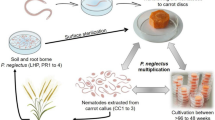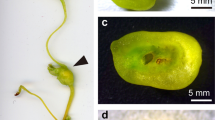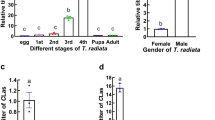Abstract
THE potato or golden cyst nematode, Heterodera rostochiensis Woll., is an important pest of potatoes and tomatoes but has never been fully described. It belongs to the group of species of Heterodera1,2 which have round cysts and do not produce an egg sac3, for which the sub-generic name Globodera was suggested4. This group includes H. tabacum Lownsbery and Lownsbery, H. virginiae Miller and Gray, H. mexicana Compos Vela, and the undescribed Osborne's cyst nematode, all with host ranges in the Solanaceae. The females of H. rostochiensis turn golden yellow after fertilization; hence the name “golden nematode”. Mean larval lengths2,5,6 range from 450 to 470 µm. In the past, control depended on rotations with infrequent susceptible crops, but recently potato varieties (Maris Piper and Ulster Glade) have been bred with a dominant gene for resistance, derived from Solanum tuberosum ssp. andigena. These resist pathotype A but not pathotype B or E populations of H. rostochiensis7. Guile8,9 showed that pathotype E females remain white until they die and become cysts, whereas pathotype B females, which produce few cysts on H. multidissectum (Hawkes), have a prolonged cream and a very short yellow phase. Webley10 showed that larvae of pathotypes B and E were longer, and had longer stylets and a greater distance between the crescentic valves of the median pharyngeal bulb and the excretory pore than larvae of pathotype A.
This is a preview of subscription content, access via your institution
Access options
Subscribe to this journal
Receive 51 print issues and online access
$199.00 per year
only $3.90 per issue
Buy this article
- Purchase on Springer Link
- Instant access to full article PDF
Prices may be subject to local taxes which are calculated during checkout
Similar content being viewed by others
References
Wollenweber, H., Ill. Candw. Ztg., 100 (1924).
Franklin, M. T., J. Helminth., 18, 63 (1940).
Jones, F. G. W., Ann. Appl. Biol., 37, 407 (1950).
Skarbilovich, T. S., Actu. Parasit. Pol., 7, 118 (1959).
Triffitt, M. J., J. Helminth., 6, 39 (1928).
Fenwick, D. W., and Franklin, M. T., J. Helminth., 25, 57 (1951).
Jones, F. G. W., and Parrott, D. M., Ann. Appl. Biol., 56, 27 (1965).
Guile, C. T., Plant Path., 15, 125 (1966).
Guile, C. T., Ann. Appl. Biol., 60, 411 (1967).
Webley, D., Nematologica, 16, 107 (1970).
Ornstein, L., and Davis, B. J., Ann. NY Acad. Sci., 121, 321, 404 (1964).
Jones, F. G. W., Rep. Rothamsted Exp. Stat. for 1969, 176 (1970).
Jones, F. G. W., J. Roy. Soc. Arts., 118, 179 (1970).
Author information
Authors and Affiliations
Rights and permissions
About this article
Cite this article
JONES, F., CARPENTER, J., PARROTT, D. et al. Potato Cyst Nematode: One Species or Two ?. Nature 227, 83–84 (1970). https://doi.org/10.1038/227083a0
Received:
Issue Date:
DOI: https://doi.org/10.1038/227083a0
This article is cited by
-
Quantitatively-inherited resistance toGlobodera pallida is dominated by one major locus inSolanum spegazzinii
Theoretical and Applied Genetics (1994)
-
The genetics of plant-nematode parasitic systems
The Botanical Review (1981)
-
More about the potato nematode,Heterodera rostochiensis Woll., in Peru
American Potato Journal (1973)
Comments
By submitting a comment you agree to abide by our Terms and Community Guidelines. If you find something abusive or that does not comply with our terms or guidelines please flag it as inappropriate.



